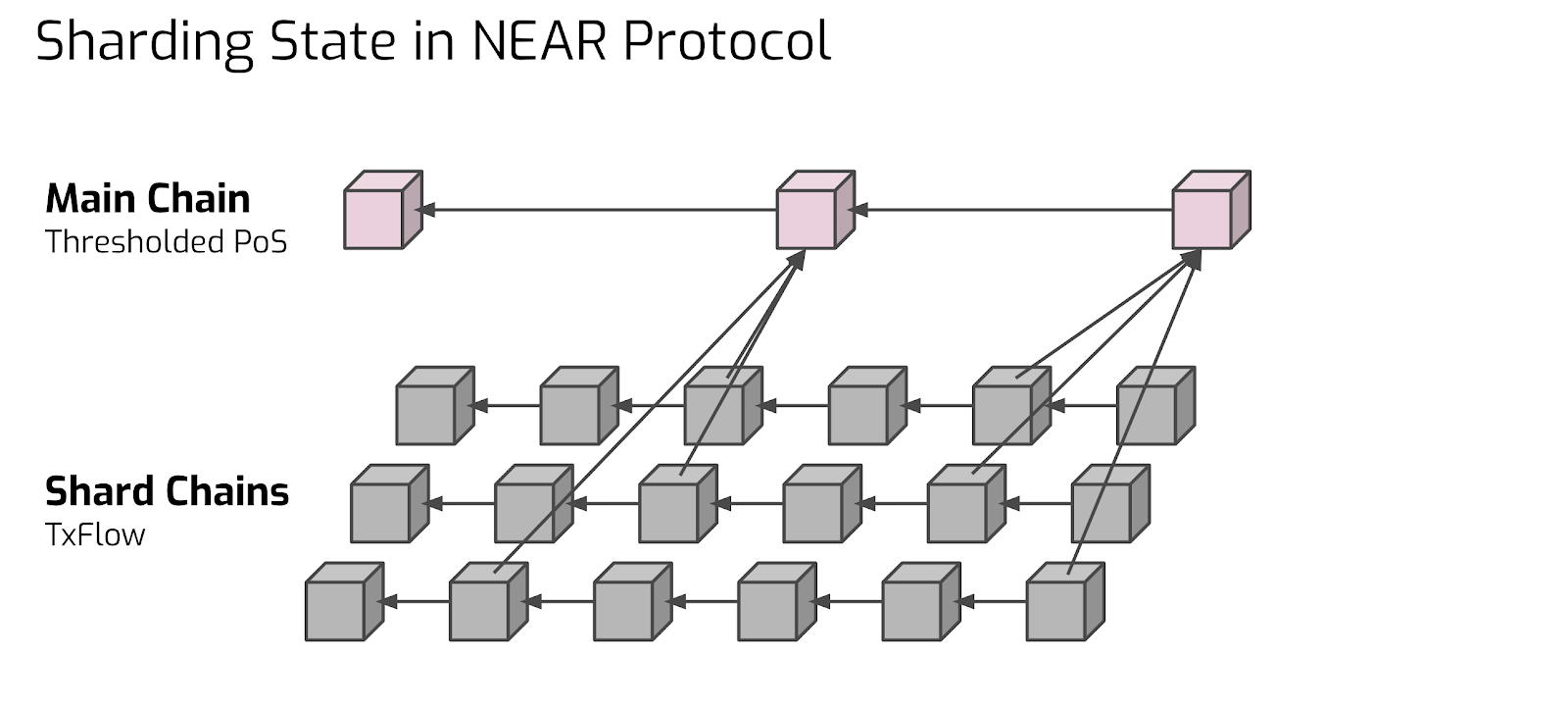Understanding Blockchain Sharding for Beginners

In the ever-evolving realm of digital ledgers, innovative methods continuously emerge to enhance scalability and efficiency. While numerous strategies exist to optimize performance, one particular approach has garnered significant attention. This concept aims to address challenges posed by an increasing volume of transactions, thereby paving the way for smoother operations.
This intriguing method hinges on the distribution of data across multiple segments, effectively alleviating the burdens that come with a centralized system. By splitting the information into manageable units, the overall responsiveness and speed can be notably improved. As the digital landscape evolves, exploring such techniques becomes increasingly important for those looking to navigate this complex domain.
As interest in these technologies grows, it becomes crucial to delve deeper into the mechanics behind this approach. A thorough exploration will unveil its potential benefits, fundamental principles, and how it can transform digital networks. Gaining insights into these practices not only enriches one’s knowledge but also equips individuals with the tools necessary to thrive in this dynamic environment.
What is Blockchain Sharding?
The concept involves optimizing the efficiency and scalability of decentralized networks by partitioning data into smaller, manageable segments. This innovative approach allows for parallel processing, significantly enhancing transaction throughput and reducing the load on individual nodes.
At its core, this method aims to overcome the limitations faced by traditional distributed ledgers, particularly as the demand for speed and capacity continues to increase. By implementing this technique, large systems can maintain high performance without compromising security or decentralization.

Key aspects of this process include:
- Division of Data: Information is segmented to enable specific clusters to manage transactions independently.
- Parallel Execution: Multiple operations can occur simultaneously across different sections, streamlining overall functionality.
- Network Scalability: The structure can expand organically, accommodating increased usage without degrading speed.
- Enhanced Performance: Overall efficiency improves as each subgroup handles less data, allowing for quicker validations and confirmations.
This innovative technique not only furthers the advancement of distributed systems but also paves the way for growing applications across various industries, driving higher user satisfaction and engagement. By focusing on improving performance while maintaining the essential characteristics of decentralization, this approach holds significant promise for the future of digital transactions.
How Sharding Improves Scalability
In today’s digital landscape, the ability to process a high volume of transactions efficiently is critical. The concept discussed here offers a way to enhance the overall capacity of a system by allowing it to manage more operations simultaneously. By dividing the workload into smaller, more manageable pieces, a significant increase in performance can be achieved.
One of the primary advantages of implementing this technique is that it minimizes bottlenecks that typically occur in traditional architectures. In a conventional framework, as the number of users or transactions grows, the system struggles to keep up, leading to delays and inefficiencies. However, by distributing the data and processes across multiple segments, the strain on any single part of the system is reduced.
This approach not only enhances speed but also improves resource utilization. Each segment operates independently, allowing for parallel processing where multiple transactions can be handled at the same time. This results in faster confirmation times and a more responsive experience for end-users, making the entire network far more efficient.
Furthermore, this model can easily adapt to growing demands. When additional resources are needed, new segments can be created without disrupting the existing structure. This scalability is essential for applications that anticipate fluctuating levels of activity, ensuring that they can accommodate future growth seamlessly.
In summary, the innovative method of partitioning workloads significantly boosts the efficiency of transaction handling. By employing this strategy, systems can effectively enhance their performance and adapt to the continuous evolution of technology and user needs.
Key Benefits of Sharding Technology
Splitting a large database into smaller, manageable pieces offers numerous advantages, greatly enhancing efficiency and performance. By distributing workloads, this methodology paves the way for improved scalability, minimized latency, and streamlined operations. Organizations can effectively harness this technique to optimize resource utilization and meet increasing demands.
Enhanced Scalability
One of the primary advantages of this approach is its ability to scale seamlessly. The division of data allows systems to handle more transactions simultaneously without compromising speed or performance. As user demand grows, additional segments can be introduced with minimal disruption, accommodating an expanding user base.
Improved Performance
By minimizing the volume of data each segment processes, performance gains are easily observable. This reduction in data load results in quicker transaction times and enhances overall responsiveness. As a result, end-users experience faster interactions, contributing to a more satisfying and efficient environment.
| Benefit | Description |
|---|---|
| Scalability | Facilitates increased transaction capacity without performance drops. |
| Performance | Reduces data processing load, leading to quicker transaction speeds. |
| Resource Optimization | Improves resource utilization by focusing on smaller datasets. |
| Reduced Latency | Decreases wait times for processes, enhancing user experience. |
Challenges and Limitations of Sharding
As networks evolve to accommodate increasing demand and operational efficiency, the partitioning of data into smaller, manageable segments presents a variety of hurdles. While this approach promises to enhance scalability and performance, it comes with its own set of complications that must be navigated carefully.

Complexity in Design and Implementation
One of the primary difficulties lies in the intricate architecture required to effectively partition the data. Developers must ensure that each segment operates seamlessly while maintaining a cohesive system overall. This imposes a significant challenge, as the interdependencies between segments can lead to inconsistency if not meticulously managed. Moreover, debugging issues becomes increasingly complex due to the distributed nature of the data.
Security Concerns
Another vital aspect is the potential security vulnerabilities introduced by segmenting the data. With distributed segments, the risk of attack vectors increases, as malicious entities may target specific segments to manipulate or disrupt the network. Ensuring data integrity becomes paramount, as a breach in any single segment could compromise the overall safety of the entire system. This necessitates advanced security measures, which can further complicate the implementation process.
Applications of Sharding in Blockchain
The innovative approach to data management has opened numerous avenues for enhancing the performance and scalability of distributed ledger technologies. By segmenting the overall workload, this method allows various operations to be processed simultaneously, leading to significant improvements in efficiency. Below are some notable applications of this technique.
- Enhanced Transaction Processing:
By distributing transactions across different segments, networks can handle a much larger volume of operations per second, reducing bottlenecks during peak usage times. - Improved Resource Allocation:
This technique enables better utilization of computational resources, as nodes can focus on specific segments, thus optimizing their performance and reducing redundancy. - Faster Data Retrieval:
Segmenting data allows for quicker access times, as queries can be processed by nodes specialized in particular segments, enhancing overall user experience. - Reduced Latency:
By distributing workload, latency can be minimized, making interactions with the network more responsive and efficient. Users experience quicker confirmation times for their transactions. - Increased Scalability:
This structure allows networks to grow in capacity seamlessly, accommodating an expanding number of users and transactions without significant performance loss. - Enhanced Security:
The decentralization brought about by dividing the data can lead to improved security postures, as it becomes more challenging for malicious actors to compromise the entire system.
In summary, the use of data segmentation within distributed systems holds great promise for enhancing the performance and reliability of these technologies. As the demands on these networks continue to expand, such innovations will play a crucial role in their evolution.
Future Trends in Sharding Development
The evolution of distributed ledger technologies has paved the way for innovative approaches aimed at enhancing performance and scalability. As the demand for efficient solutions grows, various advancements are emerging, focusing on optimizing data storage and improving transaction throughput.
One of the key trends is the integration of artificial intelligence and machine learning into the architecture. These technologies have the potential to optimize allocation strategies and enhance the dynamic management of resources across nodes, addressing performance bottlenecks effectively.
Moreover, cross-chain interoperability is set to become a crucial element in future developments. The capability to interact seamlessly with other networks will enable greater flexibility and enhance the functionality of decentralized applications, ultimately promoting a more interconnected ecosystem.

Additionally, the emphasis on privacy and security is expected to grow. As systems become more complex, robust cryptographic techniques will be essential to protect user data and maintain the integrity of transactions, ensuring trust in these evolving infrastructures.
Lastly, community-driven initiatives are likely to gain momentum, fostering collaboration among developers and researchers. This collective effort can lead to the rapid sharing of knowledge and resources, fueling innovation and addressing challenges more effectively.
Q&A: A beginner’s guide to blockchain sharding
What is blockchain sharding and why is it important?
Blockchain sharding is a scalability technique that divides the blockchain’s data into smaller, more manageable pieces called “shards.” Each shard contains its own independent state and transaction history. This approach allows different transactions to be processed simultaneously across multiple shards, significantly increasing the network’s throughput. It’s important because as blockchain networks grow, they face challenges in managing vast amounts of data and transactions. Sharding helps alleviate congestion and improves overall performance, making blockchain technology more efficient for widespread use.
How does sharding improve the scalability of blockchain networks?
Sharding improves scalability by distributing the workload across multiple shards instead of having every node in the network process all transactions. In a non-sharded blockchain, all nodes need to verify every transaction, which can lead to slow processing times, especially during high traffic. With sharding, only the nodes responsible for a specific shard need to validate the transactions within that shard. This parallel processing minimizes bottlenecks and allows the network to handle more transactions simultaneously, thus enhancing overall scalability.
Are there any drawbacks or challenges associated with blockchain sharding?
Yes, while sharding offers significant benefits, there are several challenges and drawbacks. One major concern is the complexity it introduces to the network’s architecture. Maintaining consistency and security across multiple shards can be difficult, as each shard must be correctly validated and coordinated with others. Additionally, there is a risk of what is known as “cross-shard communication,” where transactions involving multiple shards can create bottlenecks. Finally, ensuring that nodes remain fully decentralized while operating within shards is another challenge that needs to be addressed for effective implementation.
Can you explain how sharding works in a practical blockchain scenario?
Certainly! In a practical scenario of sharding, let’s say we have a blockchain that is used for processing financial transactions. With sharding, the total volume of transactions could be divided into different categories (e.g., payments, loans, investments), with each category assigned to a specific shard. For example, payments could be processed on Shard A, loans on Shard B, and investments on Shard C. When a user initiates a payment, only the nodes responsible for Shard A are involved in verifying and processing that transaction. This way, Shard A operates independently and can handle a high volume of payment transactions without being slowed down by other types of transactions that are managed on different shards. Over time, this allows the entire blockchain network to handle much larger volumes of transactions efficiently.
What are some examples of blockchain projects that utilize sharding?
Several prominent blockchain projects are actively exploring or implementing sharding to enhance their scalability and performance. For instance, Ethereum has been planning to incorporate sharding in its upgrades to Ethereum 2.0, aiming to increase transaction throughput and decrease network congestion. Another example is Zilliqa, which has implemented sharding from the ground up, allowing it to efficiently process thousands of transactions per second. Additionally, projects like Near Protocol and Harmony are also exploring sharding solutions to tackle scalability issues. These implementations showcase the potential of sharding in enabling blockchain networks to achieve higher efficiency and usability in real-world applications.
What is blockchain sharding and why is it important for scalability?
Blockchain sharding is a technique used to improve the scalability of blockchain networks. It involves splitting the entire blockchain database into smaller, manageable pieces called “shards.” Each shard is capable of processing its own transactions and smart contracts independently from the others. This division allows for parallel processing of transactions, significantly increasing the throughput of the network. Sharding is important because traditional blockchains, like Bitcoin and Ethereum, face scalability challenges as user demand grows. By implementing sharding, blockchains can handle more transactions simultaneously, leading to faster processing times and reduced congestion on the network.
How does sharding ensure security while enhancing scalability in blockchain networks?
Sharding enhances scalability by dividing the network into smaller segments, but it also raises concerns about security and data integrity. To ensure that shard structures remain secure, several strategies are employed. First, random assignment of nodes to different shards can prevent collusion, as it becomes more difficult for malicious actors to control a significant portion of the network. Additionally, cross-shard communication protocols are established to verify transactions across shards, maintaining data consistency and integrity. Moreover, mechanisms such as sharding validators can help oversee transaction processing within each shard, thereby enhancing overall security. Through these strategies, sharding can provide the scalability needed for blockchain networks without compromising security.
How does sharding improve the scalability and performance of blockchain networks?
Sharding is a scaling solution that involves dividing the blockchain network into smaller parts called shards. This allows transactions to be processed in parallel, significantly improving the scalability and performance of blockchain networks while reducing congestion.
What is the role of sharding in the Ethereum network, and how does it compare to other scaling solutions?
Sharding is a core component of the Ethereum network’s scalability roadmap. Unlike the lightning network, which is a Layer 2 solution focused on payment channels, sharding divides the blockchain into smaller, manageable pieces to improve overall network efficiency while maintaining decentralization.
Why is sharding considered a key concept in the future of blockchain technology?
Sharding is an important scaling solution because it addresses the limitations of traditional blockchain platforms, such as slow transaction speeds and high costs. By enabling the blockchain to process more transactions simultaneously, sharding may drive broader blockchain adoption and support the growing blockchain ecosystem.
How does Zilliqa implement sharding, and why is it considered a leading blockchain platform for scalability?
Zilliqa is a blockchain platform designed with sharding in its core architecture. It divides the blockchain network into smaller groups of nodes, allowing each group to process transactions independently. This makes Zilliqa a pioneer in showcasing how sharding enables high scalability and performance.
What challenges do blockchain developers face when implementing sharding, and how can they overcome them?
Implementing sharding requires careful planning to ensure security and data consistency. Blockchain developers face challenges such as designing a sharded blockchain that maintains decentralized consensus and avoids cross-shard communication bottlenecks. Solutions include using advanced cryptographic techniques and testing sharding in controlled environments before full implementation.


